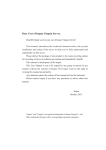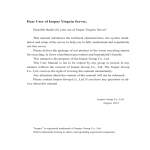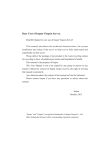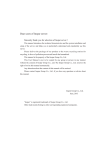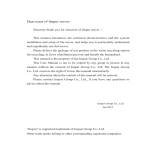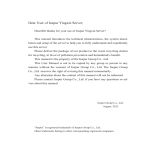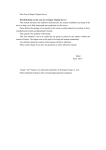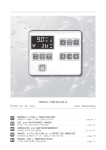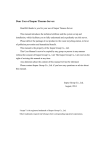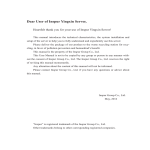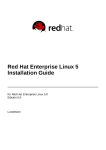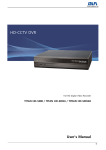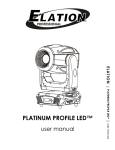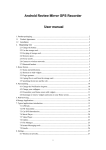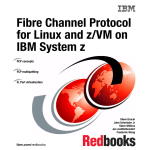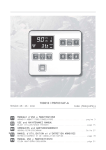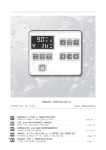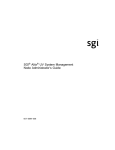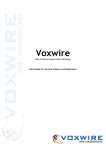Download Dear User of Inspur Yingxin Server,
Transcript
Dear User of Inspur Yingxin Server, Heartfelt thank you for your use of Inspur Yingxin Server! This manual introduces the technical characteristics, the system installation and setup of the server to help you to fully understand and expediently use this server. Please deliver the package of our product to the waste recycling station for recycling, in favor of pollution prevention and humankind’s benefit. This manual is the property of the Inspur Group Co., Ltd. This User Manual is not to be copied by any group or person in any manner without the consent of Inspur Group Co., Ltd. The Inspur Group Co., Ltd. reserves the right of revising this manual momentarily. Any alteration about the content of this manual will not be informed. Please contact Inspur Group Co., Ltd. if you have any questions or advice about this manual. Inspur Group Co., Ltd. March, 2012 “Inspur” is registered trademark of the Inspur Group Co., Ltd. Other trademarks belong to other corresponding registered companies. Statements Please read the following statements before you use this server. Only when you have read this statement hereinafter and agreed the following terms, you can formally use this server. If you have any questions about the following terms, please contact our supplier or us directly. If you have no questions about these terms and start to use this server, it acquiesces that you have agreed the following terms. 1. We must call your attention that you must not alter any other parameters in the motherboard BIOS of this server at any time, except for the parameters which we promote that you can alter. 2. If there are any hardware problems when you use this server, or you wish to upgrade the hardware, please feed back the detailed hardware configuration of your server to our Customer Service. Don’t disassemble the server case or any hardware components in the case by yourself. 3. In this server, the MEMORY, CPU, CPU Fan, Fan, Hard Disk Bracket, Hard Disk and so on are all in given standard. Please don’t use them together with the corresponding components of any other computers. 4. When you have any software problems during the application of this server, we hope that you firstly contact the corresponding software supplier and then he will contact us in favor of communication so as to solve your problem together, especially for the software problems about the installation and operation of the database, network management software or other networking products. 5. Please read carefully our user manual before you use Inspur Yingxin server. 6. We must call your attention that in the application process you should pay attention to doing necessary backup of your file. 7. This is a Grade A product, and this product may cause radio jamming. In this case, users need to adopt feasible measures to the interference. 8. When the product is out of use, please do not dispose it with other wastes. Considering the safe and green recycle utilization and humankind benefit, the user should refer to retailers or local government departments for the related disposal method and locations. 9. The copyright of the marks and names of all the software and hardware products involved in this manual is reserved by the relevant companies. 10. In the statements above, “us” indicates Inspur Group Co., Ltd; Inspur Group Co., Ltd. holds the right of final explanation about the above statements. Regard This Manual ● Chapter One Safety Information In this chapter, safety information regarding server usage is introduced. ● Chapter Two Product Introduction In this chapter the technical characteristics, appearance features, I/O interface technical specification of this server are introduced. ● Chapter Three System Setup In this chapter the setup of the main board BIOS of this server is introduced. ● Chapter Four SAS RAID Setup In this chapter, how to setup SAS RAID of onboard SAS controller is introduced. ● Chapter Five Install Operating System In this chapter, how to install the main operating system to this server is introduced. ● Chapter Six Instructions for Motherboard Management Controller In this chapter, how to use onboard management function is introduced. ● Chapter Seven Common Problems and Trouble-shooting In this chapter, solutions to some common problems are introduced. ● Chapter Eight Sever Installation Guide In this chapter, how to install server to the cabinet by rail is introduced. We suggest you read this manual seriously before you use this server for fear of the unnecessary faults in your operation. Address: Inspur Group Co., Ltd. NO.1036 Langchao Road, Jinan, China Post Code: 250101 Content Chapter One Safety Information .........................................................................1 Chapter Two Product Introduction .....................................................................6 2.1 Server Technical Specification ................................................................6 2.2 Front Panel View ......................................................................................8 2.3 Back Panel View ................................................................................10 Chapter Three System Setup ...............................................................................11 3.1 System BIOS Setup ..................................................................................11 3.2 Motherboard Jumper Settings ..................................................................19 Chapter Four SAS RAID Setup ..........................................................................21 4.1 How to Enter the Configuration Interface of SAS ..................................21 4.2 Control Key Application ..........................................................................21 4.3 SAS RAID Setup......................................................................................21 Chapter Five Install Operating System ..............................................................25 5.1 Application Instructions for Inspur Driver U Disk ..................................25 5.2 Manually Install Windows Server 2003 ..................................................30 5.3 Manually Install Windows Server 2008 ...................................................36 5.4 Manually Install Red Hat Enterprise Linux 6.1 .......................................41 Chapter Six Instructions for Motherboard Management Controller ..............45 6.1 Management Chip BMC IP .....................................................................45 6.2 Remote Login ..........................................................................................45 6.3 Function Menu Introduction ...................................................................46 Chapter Seven Common Problems and Trouble-shooting ................................55 7.1 Restarting Server ......................................................................................55 7.2 Problems When Starting the Machine ......................................................55 7.3 Machine Alarm .........................................................................................58 7.4 Additional Notes.......................................................................................58 7.5 Technical Support Information.................................................................59 Chapter Eight Server Installation Guide ............................................................60 8.1 Cabinet Preparation ..................................................................................60 8.2 Components Needed in Server Installation ..............................................61 8.3 Installation of Inner Rail ..........................................................................61 8.4 Install Guide Rail into Cabinet .................................................................62 8.5 Install the Server to Cabinet .....................................................................63 Chapter One Safety Information Chapter One Safety Information ! Warning: the following warnings show that there are potential dangers that may cause property loss, personal injury or death: Warning 1: The power supply equipment in the system may generate high voltage and dangerous electrical energy and thus cause personal injury. Please do not dismount the cover of the host or to dismount and replace any component in the system by yourself, unless otherwise informed by Inspur; only maintenance technicians trained by Inspur have the right to disassemble the cover of the host, dismount and replace the internal components. Warning 2: Please connect the equipment to appropriate power supply, and the power should be supplied by external power supply which is indicated on the rated input label. To prevent your equipment from damages caused by momentary spike or plunge of the voltage, please use relevant voltage stabilizing equipment or uninterruptible power supply equipment. Warning 3: If extended cables are needed, please use the three-core cables matched with correct earthed plug, and check the ratings of the extended cables to make sure that the sum of rated current of all products inserted into the extended cables do not exceed 80% of the limits of the rated currents of the extended cables. Warning 4: Please be sure to use the supplied power supply component, such as power lines, power socket (if supplied with the equipment) etc.. For the safety of equipment and the user, do not replace randomly power cables or plugs. Warning 5: To prevent electric shock dangers caused by leakage in the system, please make sure that the power cables of the system and peripheral equipment are correctly connected to the earthed power socket. Please connect the three-core power line plug to the three-core AC power socket that is well earthed and easy to access, be sure to use the earthing pin of power lines and do not use the patch plug or the earthing pin unplugged with cables. In case of the earthing conductors not installed and it is uncertain whether there are appropriate earthing protections, please do not operate or use the equipment. Contact and consult with the electrician, please. 1 Chapter One Safety Information Warning 6: To avoid short circuit of internal components and fire or electric shock hazards, please do not fill any object into the open pores of the system. Warning 7: Please place the system far away from the cooling plate and at the place with heat sources, and be sure not to block the air vents. Warning 8: Be sure not to scatter food or liquid in the system or on other components, and do not use the product in humid and dusty environment. Warning 9: The replacement of batteries with those of another model may cause explosion. When replacement of batteries is required, please consult first the manufacturer and choose batteries of the same or a similar model recommended by the manufacturer. Do not dismount, extrude and pink the batteries or make the external connection point short circuit, and do not expose them in the environment over 60°C. Never throw them into fire or water. Please do not try to open or repair the batteries, and be sure to reasonably deal with the flat batteries and do not put the flat batteries, the circuit boards that may include the batteries and other components with other wastes. For relevant battery recovery, please contact the local waste recovery and treatment mechanism. If what you bought is the chassis, besides carefully read the installation description attached with the cabinet products and get known about the special warning notices and installation process, you must abide by the following preventive measures to guarantee the cabinet to be stable and safe: Warning 10: Before installing equipment in the chassis, please install front and side supporting feet on the independent chassis; for cabinet connecting with other chassis, it shall install the front supporting foot first. If you fail to install correspondingly the supporting foot before installing equipment in the chassis, it may cause the cabinet to turn over in some cases, and thus may cause personal injury. Therefore, it is necessary to install supporting feet before installing equipment in the chassis. After installing the equipment and other components in the chassis, it can only pull out one component from the cabinet through its sliding component at one time. Pulling out several components at the same time may lead the cabinet to turn over and cause serious personal injury. Warning 11: Please do not move the chassis. Considering the height and weight of the chassis, at least two people are needed to complete its movement. Warning 12: Declaration 2 Chapter One Safety Information The product is Grade A product, and in the living environment, it may cause radio interference. In such case, it may need the user to take feasible measures for the interference. Notes: in order to help you use the equipment, the following considerations can help avoid the occurrence of problems that may damage the components or cause data loss: 1. In case of the following cases, please unplug the power line plug of products from the power socket and contact the customer service department of Inspur: - The power cables, extended cables or power plugs are damaged. - The products get wet by water. - The products have fallen off or been damaged. - Objects fall into the products. - When operating according to the operation instructions, the products cannot function normally. 2. If the system becomes damp, please treat it according to the following steps: - Switch off the power supplies of the system and the equipment, disconnect them with the power socket, wait for 10 to 20 minutes, and then open the cover of the host. - Move the equipment to the ventilation place to dry the system at least for 24 hours and make sure that the system is fully dried. - Close the cover of the host, re-connect the system to the power socket, and then start the equipment. - In case of operation failure or abnormal situation, please contact Inspur and get technical support. 3. Pay attention to the position of the system cables and power cables, wire them in places not to be stepped on or knocked down and ensure not to place other objectives on the cables. 4. Before dismounting the cover of host or contacting the internal components, you shall cool down the equipment first; to avoid damaging the main-board, please power off the system and wait for 5 seconds, and then dismount the components from the main-board or disconnect the connection of peripheral equipment of the system. 5. If there are modulator-demodulator, telecommunication or local area network options in the equipment, please pay attention to the following matters: -In case of thunder and lightning weather, please do not connect or use the modulator-demodulator. Otherwise, it may be subject to lightning strike. 3 Chapter One Safety Information - Never connect or use modulator-demodulator in moist environment. - Never insert the modulator-demodulator or telephone cables to the socket of network interface controller (NIC). -Before unpacking the product package, contacting or installing internal components or contacting un-insulated cables or jacks of the modulator-demodulator, please disconnect the modulator-demodulator cables. 6. In order to prevent the electrostatic discharge from damaging the electronic components in the equipment, please pay attention to the following matters: - You shall conduct off the static electricity on the body before dismounting or contacting any electronic component in the equipment. You can conduct off the static electricity on the body by contacting the metal earthing objects (such as the unpainted metal surface on the chassis) to prevent the static electricity on the body from conducting itself to the sensitive components. - For electrostatic sensitive components not ready to be installed for application, please do not take them out from the antistatic package materials. - During the work, please touch the earthing conductor or the unpainted metal surface on the cabinet regularly to conduct off the static electricity on the body that may damage the internal components. 7. When dismounting the internal components with the approval of Inspur, please pay attention to the following matters: - Switch off the system power supply and disconnect the cables, including disconnecting any connection of the system. When disconnecting the cables, please grab the connector of cables and plug it out, and never pull the cables. - Before dismounting the cover of cabinet or touching the internal components, the products need to be cooled down. - Before dismounting and touching any electronic component in the equipment, you shall conduct off the static electricity on the body by touching the metal earthing objectives. - During the dismounting process, the operation shall not be too big, so as to prevent damage to the components or scratching of the arms. - Carefully deal with the components and plug-in cards, and please never touch the components or connection points on the plug-in cards. When taking the plug-in cards or components, you should grab the edges of the plug-in cards or components or their metal fixed supports. 4 Chapter One Safety Information 8. During the process of cabinet installation and application, please pay attention to the following matters: - After the installation of cabinet is finished, please ensure that the supporting feet have been fixed to the rack and supported to the ground, and all weight of the rack have been fell onto the ground. - It shall install into the cabinet according to the sequences from the bottom to the top, and first install the heaviest component. - When pulling out the components from the cabinet, it shall apply force slightly to ensure the cabinet to keep balance and stabilization. - When pressing down the release latch of the sliding rail of components and sliding in or out, please be careful, as the sliding rail may hurt your figures. - Never make the AC power branch circuit in the cabinet overload. The sum of cabinet load shall not exceed 80% of the ratings of branch circuits. - Ensure that components in the cabinet have good ventilation. - When repairing components in the cabinet, never step on any other components. 5 Chapter Two Product Introduction Chapter Two Product Introduction 2.1 Server Technical Specification Processor Processor type Interface Two-way Intel® Xeon E5-26XX series CPU (Up to two pieces 130w) Two 2011 pin slots Chipset Chipset type PCH Memory Memory type DDR3 Unbufferd/ECC Registered memory RAM slot number 24 RAM capacity Up to 192GB(8GB per ) I/O Interface USB interface 4 rear USB interfaces 2 front USB interfaces Serial interface One rear serial interface , one built-in serial interface Network interface 2 Gigabit network card interfaces and 1 management interface Display interface 1 front VGA interface (no front VGA interface with 17-24 pieces of HDDs) 1 rear VGA interface UID interface 1 UID (blue) and UID button Display controller Controller type Onboard AST2300 display controller Video memory 16MB video memory SAS Back plane SAS2.0 back plane Support hot-plug SAS/SATA hard disk Network card Network controller Integrated 1 Intel 82576EB two Gigabit network cards 6 Chapter Two Product Introduction Management chip Management chip Integrated A speed 2300 chip, support BMC and KVM functions PCI expansion slot Expansion slot is inserted by riser card. And the standard configured riser cards’ specifications are: Left riser card: Support 3 PCI-E 2.0 x8 slots. Left riser card supports 2 full-height &full-length as well as 1 half-length & low-profile board cards (configuration with two CPU) Right riser card: Support 1 PCI-E 2.0 x16, 1 PCI-E 2.0 x8 slots. Right riser card supports 2 full-height & full-length board card (only configuration with two CPUs can support x8 slot) Hard disk Hard disk type 2.5″ SAS and SATA hard disk External storage drive CD drive Slim SATA DVD drive ( the server with 17-24 hard disks can not be configured with Slim DVD drive) Driver U disk Optional driver U disk Power supply Specification 600W and above 1+1 redundancy Power input Please refer to the power input label on the host nameplate Physical dimensions Package box outer size W(Width)966mm;H(Height)636mm;D(Depth)409mm Main chassis size W(Width)432mm;H(Height)88 mm;D(Depth)745mm Product weight Standard configuration (3 hard disks): Main chassis weight: 19.5 kg Gross weight: 32kg (include main chassis + package box + guide rail + accessories box) Full configuration (24 hard disks): Main chassis weight: 25.8 kg Gross weight: 36.75kg (include main chassis + package box + guide rail + accessories box) 7 Chapter Two Product Introduction Environment parameter Operating environ10℃ 10 -35℃ ℃ -35 ℃ ment temperature Storage and trans-40℃ -40 -55℃ ℃ -55 ℃ port temperature Operating humidity 35%-80% relative humidity Storage and trans20%-93% (40℃ (40℃ )relative humidity port humidity 2.2 Front Panel View Notes: The pictures are for reference only; please refer to your actual machines. ● Front panel view Number Name Introduction 1 Front USB interface For connecting the USB devices 2 Front USB interface For connecting the USB devices 3 Hard disk bay For installing 1-8 pieces of hard disks 4 Hard disk bay For installing 9-16 pieces of hard disks 5 Hard disk bay For installing 17-24 pieces of hard disks 6 CD drive slot Optional Slim CD drive (no Slim CD drive for configuration of 17-24 pieces of hard disks) 7 Power indictor light Power light is always green when server runs; power light is off when server stops. 8 Power button Server on/off button 9 ID light button To turn on the ID light. 10 Blinking: network is connected or data is Network card 2nd and transmitting (green); 4th indicator light Off: network is not connected 8 Chapter Two Product Introduction 11 It warns fan failure. This light is always off when the system is in normal status. Fan failure indicator The light is always amber in case of syslight tem fan failure. (The light is also amber when server is turned off, AC power is connected and BMC is initialized.) 12 It warns the abnormal status of the system such as over-high temperature (amber). Abnormal system in- (This light is always off when the system dicator light works normally. But the light is also on when the server is connected with AC and BMC is initialized.) 13 Blinking: network is connected or data is Network card 1st and transmitting (green); 3rd indicator light Off: network is not connected 14 ID light User machine-locating light(blue) 15 Front VGA interface For connecting display devices ● Hard disk tray indicator light Name Function and introduction Hard disk working status indictor light The light is always green when hard disk is reading and writing. Hard disk failure alarm indictor light The light is always red in case of hard disk failure. The light is always blue when hard disk is being located. The light is always purple when RAID card is rebuilding. 9 Chapter Two Product Introduction 2.3 Back Panel View Back Panel View No. Name Function and introduction 1 Power input interface For connecting power line 2 PCI-E expansion slot For inserting the external PCI-E expansion card. 3 Serial interface For connecting serial interface devices. 4 VGA interface For connecting display devices. 5 10 Gigabit network interOptional 10 Gigabit network face (Optional) 6 Management interface For the usage of onboard IPMI management function. 7 Network card 1 interface Integrated Gigabit network card 1 interface 8 Network card 2 interface Integrated Gigabit network card 2 interface 9 Rear USB interface For connecting USB interface devices. 10 light and its button To turn on ID light. 11 Rear USB interface For connecting USB interface devices. 12 Optional integrated Gigabit network card 3 Network card 3 interface interface (need to configure special mother (Optional) board) 13 Optional integrated Gigabit network card 4 Network card 4 interface interface (need to configure special mother (Optional) board) 10 Chapter Three System Setup Chapter Three System Setup In this chapter, the wire jumper of motherboard and BIOS function setup of this server are introduced. Only operator or administrator with qualification of system maintenance can implement these operations described in this part. 3.1 System BIOS Setup BIOS is the basic input and output system. With some special setting programs, it can adjust the system parameter and the hardware parameter. BIOS has great influence on the starting and running of the system so that setting parameters improperly may arise the conflict among hardware resources, or affect the system’s performance. Hence understanding the BIOS setup is significant to the configuration of your server. If there is no especial requirement, we suggest you using the default value and not altering the parameters at will. Notes: 1. Before the server BIOS setup is altered, please record the corresponding original setup. Hence when there are operating problems in the system due to the alteration, the setup can be restored. 2.The factory default system value is usually the optimized setup. Don’t try to alter the parameters before you understand their denotations. 3.The common setup is introduced in detail in this chapter. The less referred options in the application procedure are explained simply or not mentioned. 4.The contents of the BIOS may be differing based on the different configurations of the products; hence the detailed introduction is elided. 3.1.1 How to Enter BIOS Setup Power up and start the server, then the system begins to boot. When “Press <DEL> to SETUP or <TAB> to POST” appears at the bottom of the screen, please press <DEL> key. The system will enter BIOS setup. If the system does not enter BIOS setup after previous steps, please press <Ctrl><Alt>and<Del> at the same time to reset the system and repeat the previous steps. (If the prompt displays to press <DEL> again, please press it quickly.) There are some items that cannot be set in BIOS, for example some informa- 11 Chapter Three System Setup tion on system’s automatic detection and configuration. A right-pointing signal may be found before some items, which means this item is selected, and press <Enter >, the system will enter the cascading menus (i.e. submenus). 3.1.2 BIOS System Menu Introduction The following some main function menus in BIOS will be introduced in this section: Menu name Menu function Main Configuring the basic system setup, like the system time and date, and displaying the information of BIOS. Advanced Configuring advanced characteristics of CPU, integrated SATA controller and others. Chipset Configuring memory mode, CPU feature and others Server Mgmt Boot Security Save & Exit BMC information and management BMC Configuring boot order of each device in the system Configuring the super user and user’s password. Saving or exiting BIOS, etc. Operation key introduction: Key Description <↑> For selecting the upper menu or value <↓> For selecting the next menu or value <← > For selecting the left menu or value <→> For selecting the right menu or value <ESC > For returning to the superior menu or the main menu <+> For changing the item value for changing the current menu item into the next item value The key only displays the item values relevant to the item itself rather than all the item values <-> For changing the item value for changing the current menu item into the previous item value The key only displays the item values relevant to the item itself rather than all the item values <F1 > The help key for displaying the relevant explanation of current menu 12 Chapter Three System Setup <F2 > For restoring to the default setting of the system safety performance, Load Previous Values <F9 > For restoring to the default setting of the system best performance <F10 > For saving the CMOS’s setting and exiting <Enter> For operating current order or entering submenu 1. Main menu The Main menu appears first when entering the BIOS setup system. The BIOS version information and memory capacity can be examined here. And the system date and time can be set. ● BIOS Information Show the BIOS version and BIOS modification time. ● Memory Information Show the system memory capacity ● System Date Set the system date, in format of [week month/day/year]. ● System Time Set the system time, adopting 24-hour system, in format of [hour/minute/second] 2.Advanced menu Advanced menu mainly includes the following submenus or configuration items: ACPI Settings CPU Configuration Intel(R) VT for Directed I/O Configuration SATA Configuration USB Configuration Serial Port Configuration PCI Subsystem Settings Runtime Error Logging WHEA Configuration Onboard LAN Configuration Serial Port Console Redirection 13 Chapter Three System Setup The following will introduce main and common items. The menu is mainly used to set to enhance characteristics. Improper setting may cause the abnormal system operation, so please keep factory default settings. ● CPU Configuration * Socket 0/1 CPU Configuration Show the detailed information of CPU0/1, including CPU main frequency size, maximum main frequency, minimum frequency, CPU core number, level one cache, level two cache, level three cache size, whether support hyper-threading and VT-X technology and other information. * Hyper-threading * Hyper-threading CPU hyper-treading function setup includes [Enabled] and [Disabled] two items. The default setup is enabled. * Active Processor Cores Activate all cores of the CPU, including [All], [1], [2], [4] and other items. The default is [All]. * Intel Virtualization Technology CPU virtualization technology supports function setup, including [Enabled] and [Disabled] two items. The default is enabled. * CPU Power Management Configuration Enter this item to manage CPU power consumption. Power Technology Include [Disable], [Energy Efficient], [Custom] three items. Energy Performance Include [Performance], [Balanced Performance], [Balanced Energy] and [Energy Efficient] four items. ● Intel(R) VT for Directed I/O Configuration * Intel(R) VT-d Whether Directed I/0 supports Intel virtualization technology or not, including [Disabled] and [Enabled] two items, the default is [Disabled]. ● SATA Configuration Enter this item to view the SATA devices connected with each SATA interface. * SATA Mode This item is used to set onboard SATA controller mode, including [Disabled], [IDE 14 Chapter Three System Setup Mode], [AHCI Mode] and [RAID Mode] four items. If you want to use serial devices as parallel IDE storage devices when onboard SATA controller is used, please set this item to [IDE Mode]. If you do not create RAID and want to connect 1-2 SATA devices when onboard SATA controller is used, please set this item to [AHCI Mode]. If you want to create Intel SATA HostRAID when onboard SATA controller is used, please set this item to [RAID Mode] (only support Windows system at this time). * Serial-ATA Controller 0 This item only appears when SATA Mode option is set to [IDE Mode]. At this time, it supports 2 SATA 3.0Gb/s devices when set to [Enhanced]. Under the Windows 98/NT/2000/MS-DOS system, this item needs to be set to [Compatible], which can support 2 serial devices at this point. ● USB Configuration This menu is used to set some configuration related to USB and displays the USB devices that the system automatically detects. * Legacy USB Support The traditional USB devices support function setup, including [Enabled], [Disabled] and [Auto] three options. If set it to [Auto], the default does not support traditional USB devices when USB devices are not connected. ● Onboard LAN Configuration Legacy OpROM Support * Launch PXE OpROM Include [Disable] and [Enable] two items, and the default is [Disabled]. 3. Chipset menu ● CPU Advanced Settings This menu is used for the setup of QPI related information and memory related items. * QPI Configuration The submenu of this submenu can set up QPI speed mode, frequency and other items. * DIMM Information The sub items of this menu can show memory configuration information, including memory total capacity, current memory configuration mode and so on as well as setup of memory mode and memory rate, etc. 15 Chapter Three System Setup ▼ Intel(R) I/0AT This item is used to open or close Intel I/O acceleration technology, including [Enabled] and [Disabled] two items. ▼ VGA Priority Set priority order of integrated graphic card and external graphic card, including [Offboard] and [Onboard] two items. ▼ Memory Mode Memory mode setup, including [Independent], [Mirroring], [Lock Step] and [Sparing] ● PCH Display and setup of PCH related information. * SMBus Controller This item is used to open or close system bus controller, including [Enabled] and [Disabled] two items. * Restore AC Power Loss Set power supply status after system powers off. [Power off] is shutdown status which needs to start up manually. [Power on] is the automatic startup status. * Onboard SATA RAID Oprom This item is used to open or close integrated SATA RAID controller rom, including [Enabled] and [Disabled] two items. ● ME Subsystem This menu is used to show ME subsystem related information, including BIOS interface version information, version, FW status, FW alarm code and other information. 4. Server Mgmt menu ● Wait For BMC This item is used to setup whether waiting for BMC startup or not, including [Enabled] and [Disabled] two items. ● System Event Log This menu shows the features of system event log. ● View System Information Enter this menu to check system related information, including product name, product manufacturer, product version, product serial number, SDR version information, BMC version information and others. ● BMC network configuration 16 Chapter Three System Setup This menu is used to setup the configuration information of BMC network interface. * Lan channel 1 Related items of this menu can be used to setup the access method to network card IP address, IP address, subnet mask and router IP address and other information. * Lan channel 2 Related items of this menu can be used to setup the access method to IPMI management dedicated interface IP address, IP address, subnet mask and router IP address and other information. 5. Boot menu Boot menu is mainly used for system setup and priority settings of system boot devices. ● Quiet Boot This menu includes [Enabled] and [Disabled] two items. If the system is set to [Disabled], it shows normal self-check information when system boots. If the system is set to [Enabled], it shows OEM LOGO instead of self-check information. ●Boot Option #1/#2 Enter this menu and select certain boot order device item. Press <Enter> button and the system will display optional boot device table. Then select a device through arrow key in the table and press [Enter] to finish the setting of the boot order item. ● Hard Drive BBS Priority Press <Enter> to enter the sub items of this menu, to setup the boot order of the devices. 6. Security menu ● Administrator Password This menu is used to setup system administrator password. After the setup of the administrator password, you must input the password when enter the BIOS setup progress. ● User Password This menu is used to setup user password. After the setup of the user password, you must input the password when boot and enter the BIOS setup progress. In the setup interface of BIOS Setup, you have the same authority to administrator after entering the password. 17 Chapter Three System Setup 7. Save & Exit menu The options in this menu can be used to save or discard the settings of the changes in the BIOS and exit the setting program. ● Save Changes and Exit Select this item and press [Enter]. After you select <Yes> for confirmation, the changes in the BIOS settings will be saved and the system will exit the BIOS setup. The menu function can use [F10] shortcut key to realize. ● Discard Changes and Exit Select this item and press [Enter]. After you select <Yes> for confirmation, the changes in the BIOS settings will be discarded and the system will exit the BIOS setup. ● Save Changes and Reset Select this item and press [Enter]. After you select <Yes> for confirmation, the changes in the BIOS settings will be saved and the system will exit the BIOS setup, and then reboot the computer. ● Discard Changes and Reset Select this item and press [Enter]. After you select <Yes> for confirmation, the changes in the BIOS settings will be discarded and the system will exit the BIOS setup, and then reboot the computer. ● Saving Changes Select this item and press [Enter]. After you select <Yes> for confirmation, the changes in the BIOS settings will be saved and the system will not exit the BIOS setup. ● Discard Changes Select this item and press [Enter]. After you select <Yes> for confirmation, the changes in the BIOS settings will be discarded and the system will not exit the BIOS setup. ● Restore Defaults Select this item and press [Enter]. After you select <Yes> for confirmation, the system will load system default optimization setup and the system will not exit the BIOS setup. This menu function can use [F9] shortcut key to realize. ● Save as User Defaults Select this item and press [Enter]. After you select <Yes> for confirmation, the system will save the current items setup values of the BIOS as the user default value. ● Restore User Defaults 18 Chapter Three System Setup Select this item and press [Enter]. After you select <Yes> for confirmation, the system will load user default menu. ● Boot Override Select the device item of this menu. After you select <Enter> for confirmation, then it will boot system from the selected device. 3.2 Motherboard Jumper Settings Motherboard jumper setting is the operation of shorting cut two pins of the jumper to change the interface functions. Refer to the following figure, and adjust the motherboard functions. Figure of jumper settings Open the Chassis Upper Panel If motherboard jumper change is needed, please get the authorization of Inspur Group Co., Ltd. according to the methods as follows to open the chassis upper panel: 1. Power off the system (turn off the AC power), then loosen the screws fixed on the upper panel of the chassis; 2. Loosen the screw built on the rear point of the upper panel of the chassis. 3. Remove the upper panel according to arrow in the picture below. 19 Chapter Three System Setup Clearing CMOS Jumper Introduction CLR-CMOS Jumper Location View Jumper Number Function description Jumper function CLR_CMOS CMOS clearing jumper Normal state :short cut the pin 1 and 2 Clean CMOS: short cut the pin 2 and 3. Notes: When clearing CMOS, the system must be shut down, and cut off the power supply. Short cutting pin2 and 3 need to keep for 5 seconds; then use the jumper cap to short cut pin 1 and 2 (default settings)of the CLR_CMOS to restore the original state. 20 Chapter Four SAS RAID Setup Chapter Four SAS RAID Setup This chapter mainly introduces the configuration of onboard SAS controller RAID and its application method. If the server you purchased does not use onboard SAS RAID, you can not refer to this chapter. If you use onboard SAS RAID, you need to enter BIO, set the Chipset→PCH→SCU devices item to [Enabled], and then set Onboard SAS Oprom item to [Enabled]. 4.1 How to Enter the Configuration Interface of SAS RAID 1. During boot, the screen will display: Press [CTRL-I] to enter Configuration Utility… 2. Press [Ctrl][I] to enter SAS RAID configuration interface. 4.2 Control Key Application Key Description ↑↓ For moving cursor and modifying menu option value in different menus TAB For selecting the next menu configuration items Enter For selecting menu Esc For exiting menu or back to the previous menu from submenu 4.3 SAS RAID Setup After entering the SAS RAID configuration interface, these information will pop out, including the menu list information, the information of the HDDs connected to the SAS controller (HDD ID number, HDD model, HDD capacity and whether the HDD is part of the volume, etc), the existing RAID volume information (including volume ID number, name, RAID level, capacity, state and whether can boot information), as show in the below figure: 21 Chapter Four SAS RAID Setup The executable menus of the configuration interface of SAS RAID are the following four: ● Create RAID Volume ● Delete RAID Volume ● Reset Disks to Non-RAID ● Exit Exit the configuration interface of SATA HostRAID. Ⅰ . Create RAID Volume menu After entering the configuration interface of SAS RAID, it can select the menu with up and down arrow keys, and then press Enter key to create RAID volume menu or input the number key before menu to create RAID volume menu. The system will display the following menu options: Name: Please input the volume name of less than 16 characters without special characters. RAID Level: Level: Please select RAID volume level. If it has not created volume at present, there are four volumes for selection, such as RAID0(Stripe) RAID0(Stripe),, RAID1 RAID1((Mirror Mirror)), RAID10(RAID0+1) and RAID5( RAID5(Parity Parity)), and please select the levels based on the actual demand. RAID0: it allows 2 or more than 2 hard disks to form this RAID volume. RAID1: it allows 2 hard disks to form this RAID volume. RAID10: it allows 4 hard disks to form this RAID volume with 4 or more hard disks. 22 Chapter Four SAS RAID Setup RAID5 (Parity): it allows 3 and more than 3hard disks to form this RAID volume. Disks: select hard disks to be used to form RAID volume, select this option and press Enter key, it will enter the hard disk selection interface, please press Space key to select the hard disk in turn to form RAID volume, and then press Enter key to return the menu interface of volume creation. Strip Size: please select the size of strip of volume, and only volumes RAID0 and RAID5 can select this option. Capacity: Set the size of volume capacity, which is defaulted as the maximum capacity. Alter all the setting above have been done well, please select<Create Volume>, and press <Enter>, the screen will display: “WARNING:ALL DATA ON THE SELECTED DISKS WILL BE LOST. Are you “WARNING: sure you want to create this volumes? (Y/N):” (Y/N):”.. If the creation of RAID volume is confirmed, please enter “Y”, the volume will then be created, and at the same time, all the data on the selected hard disk will be lost. If not to create RAID volume, please enter “N” and exit the creation of volume. Here, we enter “Y” and create RAID volume, after the creation, return to the main configuration interface of SATA HostRAID, and will display the created RAID volume in the RAID volume. Ⅱ.Delete RAID Volume menu Ⅱ.Delete After entering the configuration interface of SAS RAID, it can select the menu by up and down arrows, and then press Enter key to enter the menu of Delete RAID volume or input the number key before menu to enter the menu of Delete RAID volume. System warning: “Deleting a volume will reset the disks to non-RAID. ALL DISKS DATA WILL BE DELETED.” If it confirms to delete RAID volume, please press <DEL> key, and the system will pop up again the warning: “ALL DATA IN THE VOLUME WILL BE LOST! Are you sure you want to delete “Volume*”? (Y/N):”, and if yes, please enter “Y”, if not, please enter “N”. III. Reset Disks to Non-RAID menu After entering the configuration interface of SAS RAID, we can select the menu by up and down arrows, and then press Enter key to enter the menu or enter directly. The system will display all hard disks in RAID volume. Please select hard disks 23 Chapter Four SAS RAID Setup to be reset by Space key based on actual demand, and then reset hard disk by pressing Enter key. The system will again warn whether there is a need to reset the hard disk, and enter Y or N according to the promotes. It should note that when resetting the hard disks, all data on hard disk will be lost, and at the same time, the hard disk will never again belong to RAID volume. Ⅳ . Exit menu After entering the configuration interface of SAS RAID, it can select the menu by the up and down arrows, and then press Enter key to enter the menu. System warning: “Are you sure you want to exit? (Y/N):”. Enter “Y”, and then it will exit the configuration interface of SAS RAID; while enter “N”, it will cancel the operation and exit. 24 Chapter Five Install Operating System Chapter Five Install Operating System This chapter primarily focuses on the method for manually installing the major operating system on the server. For operating steps of Ruijie intelligent installation operating system, refer to corresponding chapters and sections of Ruijie Server Kit User Manual. During manual setup of the operating system, some operating system may need the floppy drive or Inspur driver U disk to load the driver of hard disk controller. Refer to the readme.pdf file under the root directory in Inspur driver CD for the making method of the driver floppy disk. If the system you purchased is configured with Inspur driver U disk, you may refer to relevant contents of this chapter for the making method of Inspur driver U disk. After logging the driver CD making interface, you can check and make the controller driver needed to load in the process of operating system installation under related configuration. If your server is configured with external RAID card, please refer to the User Manual in the attached CD of external RAID card to add hard disk controller driver. As for the graphic card and system patch program, you still can refer to this chapter for installation. It is suggested that you confirm in advance that the purchased machine configuration supports the version of the installed operating system. 5.1 Application Instructions for Inspur Driver U Disk Under Windows system and Linux system, Inspur driver U disk can be identified as two parts: simulation floppy driver [3.5 floppy disk (A :)] and normal partition of U disk [UDISK PRO]. When you install some operating systems manually, you can use Inspur driver U disk to load the drive of hard disk controller (at present, the operating systems that use Inspur driver U disk to load support of the hard disk controller are Windows XP or above versions, Red Hat Linux 4.5 or above versions, and Suse Linux 9.0 SP2 or above versions systems). Warning: During the installation of the operating system by using Inspur driver, it may detect Inspur driver U disk on the disk partition interface, at this moment, the 25 Chapter Five Install Operating System user must distinguish U disk from hard disk, and never delete or format U disk. During the installation of the operating system, if it needs to boot the system from hard disk after reboot, it must enter the server BIOS for setting to ensure the starting sequence of hard disk is prior to the starting sequence of U disk and the system can be booted from the disk. If the starting sequence of U disk is prior to the starting sequence of hard disk, the system will fail to be booted from hard disk. The following introduces the making method for the driver of onboard hard disk controller when using Inspur driver U disk to install the operating system. For driver making of external RAID card or SAS card, please refer to the corresponding contents in the driver CD for external board card. Make Driver 1. Prepare a set of computer installed with Windows system, and connect the Inspur driver U disk to the USB interface of the computer, as shown in the picture below. Inspur driver U disk will be identified as two parts: simulation floppy driver [3½ Floppy (A)] and normal partition of U disk [Removable Disk (E:)], in which, the disk character E in [Removable Disk (E)] will be different according to the actual partitions of your computer. Notes: Before connecting the Inspur driver U disk to the computer, if your computer is configured with standard floppy, please enter BIOS and close this 26 Chapter Five Install Operating System standard floppy; if your computer is connected with USB floppy, please first disconnect USB floppy. It must guarantee that when the Inspur driver U disk is connected to your computer, the analog floppy disk under Windows system shall be identified to be A:, and only by this can the normal making of subsequent driver be guaranteed. 2. Put the driver CD (Inspur driver CD and RAID card driver CD) into the CDROM, and the driver making software will operate automatically. If the system forbids the automatic operation of CD, please enter CD directory and operate documents of dolphin.bat (Inspur driver CD) in CD or setup.exe (RAID card driver CD) in CD directory. 3. Methods for making drivers by using Inspur driver CD: (1) After operating dolphin.bat documents, the system will enter the interface of “Input navigation No. please:” Input the navigation code in the text box (the navigation code is shown in CD box), click [OK] button, and it can log in the main interface of driver making software. Click [Cancel] button and exit the logging. (2) Having input the navigation code and logged in the system, enter the main interface of driver making software, and the main interface is shown in the following picture: 27 Chapter Five Install Operating System (3) Click the [Make Drive] button and enter the driver making interface, as shown in the following picture: (4) After you select the corresponding operating system and the controller driver to be made according to the actual need, click [Next] button and make corresponding driver. Different operating systems correspond to different making interfaces and methods of the driver. ● Driver making of Windows system When the driver of Windows operating system is made, copy the driver directly 28 Chapter Five Install Operating System into the simulation floppy drive A: of Inspur driver U disk. Select the Windows version to be installed and driver to be made, and then click [Next]. The system will display a prompt as shown in the following picture. Please confirm that Inspur driver U disk is well connected, and format the floppy A: of Inspur driver U disk, and then click [OK] to start the driver making. After the driver making is completed, the system will pop up the window, prompting “Driver has been completed”, and click <OK> to complete the making of driver. ● Notices for using Inspur driver U disk to load drive under windows system During the installation of Windows operating system, if the driver of hard disk controller is loaded by using Inspur driver U disk, entering the interface of disk partition, the Inspur driver U disk will occupy a disk letter. If the disk is not divided, U disk will occupy disk C: and if the disk has other partitions, U disk will occupy other disk letter (please distinguish according to the actual hard disk partition). If there are other partitions on the disk, at this moment, it needs to delete all of them and then create new partitions on the hard disk, and the U disk will not occupy disk letter any more. If the disk is not divided, it needs to create one disk partition on the unallocated space, and then delete this newly created disk partition. And at this time the U disk will not occupy any disk letter any more. Then create disk partition based on actual need, and complete the installation of operating system according to the instructions. Notes: Be sure to distinguish U disk from hard disk, and never delete or for- 29 Chapter Five Install Operating System mat U disk. 5.2. Manually Install Windows Server 2003 5.2.1 Preparation Prior to Installation ●Installation CD for Windows Server 2003 Enterprise SP2 (here take 32 bit operating system installation as an example) ●Inspur driver CD ●RAID card drive floppy disk (made by Inspur RAID card driver CD, for details please refer to the electric version of RAID card driver CD user manual.) Notes: if you use Inspur driver U disk to load controller drive, please refer to the attached Inspur Driver U disk Instructions for guide. ● Please connect well the USB floppy drive or Inspur driver U disk before the system starts up. 5.2.2 Installation steps 1. Power up to start the server, and put the installation CD of Windows Server 2003 into CD drive and then enter the BIOS to configure so that the server can be booted from CD. 2. Press any key when the system presents “Press any key to boot from CD” and the system will start Windows installation program from CD. 3. When the screen presents “Press F6 if you need to install a third party SCSI or RAID driver...” please press [F6] key. Notes: when installing EMT64bit version system, if it prompts the server type purchased, you can select configuration according to the detailed configuration of purchased server. When the system displays “Setup could not determine the type of one or more mass storage…”, press ‘S’ key. When the system prompts to insert a floppy disk, after selecting “LSI MegaRAID SAS RAID Controller Driver (Server 2003 32-bit)” in the drive list, press [Enter] to load driver. If Inspur driver U disk is used (please connect Inspur driver U disk well before the system starts up.) Firstly, ensure that the corresponding driver has been made into the [3.5 Floppy disk (A:)] partition of the Inspur driver U disk. Select “LSI MegaRAID SAS RAID Controller Driver (Server 2003 32-bit)” and then press [Enter] to load driver. The system starts loading the driver; after the driver is loaded, press [Enter] to 30 Chapter Five Install Operating System continue to install according to the on-screen prompts. 4. The system displays “Welcome to Setup” This portion of the Setup program prepares Microsoft(R) Windows(R) to run on your computer. ⊙ To set up Windows now, press [ENTER]. ⊙ To repair a Windows installation using Recovery Console, press R. ⊙ To quit Setup without installing Windows, press F3. Here we default it as the installation for the first time, so choose to press [Enter] to continue installation. 5. The system displays Windows Licensing Agreement. The user can read the licensing agreement by pressing <Page Down> key. After finishing the reading or not reading the agreement, you can directly press [F8] key to accept the agreement. 6. The system displays The following list shows the existing partitions and unallocated space on this computer. Use the UP and DOWN ARROW keys to select an item in the list. ⊙ To set up Windows on the selected item, press [ENTER]. ⊙ To create a partition in the unallocated space, press C. ⊙ To delete the selected partition, press D. You can select the items based on the actual situation, select the unallocated space here and then press <C> key. Notes: if the Inspur driver U disk is used to load hard disk controller driver, please first refer to attached Inspur Driver U Disk User Manual to delete the disk letter occupied by Inspur driver U disk. 7. Program installation prompts: ⊙ To create the new partition, enter a size below and press [ENTER]. ⊙ To go back to the previous screen without creating the partition, press ESC. The minimum size for the new partition is 8MB. The maximum size for the new partition is XXXMB. XXXMB.((XXX means the maximum capacity of the disk disk)) Create partition of size <unit: MB>: Press [Backspace] to delete the numeral in the frame, input the size of the disk partitions you want to create and then press [Enter] to continue. 31 Chapter Five Install Operating System Notes: it is suggested that the partition should be more than 10GB. 8. The system displays the interface of Step 6, here select the partition of “Partition1 [New <Raw>]” and press [Enter] key to continue the installation. 9. System displays The selected disk partition has not been formatted, and the installation program will immediately format this disk partition. Use the UP and DOWN ARROW keys to select the file system needed, and then press [Enter]. To select different disk partition for Windows, press [Esc]. ⊙ Format the partition using the NTFS file system (Quick) ⊙ Format the partition using the NTFS file system Select “Format the partition using the NTFS file system” (it is suggested to use) and press [Enter] to format the disk partition. 10. The system display: Please wait while installation program is formatting the disk partition on …. The system displays the progress bar of formatting. After the installation program formats the new partitions, it will prompt “Please wait while installation program copies files to the Windows installation folders. This might take several minutes to complete.” The system will display the progressive bar of document duplicating. After the duplication of document, take out the driver floppy or disconnect Inspur driver U disk, and the system will restart automatically. 11. After the system restarts, select to boot from hard disk. Install wizard collects relevant information and prepares to install. The installation program detects and installs the equipment, and during the process, if prompts of “software installation” and “hardware installation” etc. pop up, click “YES” to continue. After the completion, the system will automatically take the next step. 12. The system displays: Regional and Language Options: you can use different region and language to user define Windows. If you need to change setup, please click [Custom] button to configure according to demands. It is suggested using the default setting, and here click <Next> to continue the in- 32 Chapter Five Install Operating System stallation. 13.. Personalize Your Software 13 The installation program will self-define your Windows software based on the personal information you provided. Input your full name and the name of the company or organization. Name: Organization: The user can fill in according to his actual situations and then click <Next> to continue the installation. 14. Input your Product Key (25-character) and then click <Next> to continue the installation. 15. Licensing Models 15. Windows Server 2003 supports two licensing models. ⊙ Per server. Number of concurrent connections (V): Each connection must have its own Client Access License. ⊙ Per Device or PerUser (S). Each device or user must have its own Client Access License. The user can select and set according to his demands and then click <Next>. 16. Input Computer Name and Administrator Password. 16. You must provide computer name and administrator password. After setting the computer name (not more than 15 characters) and administrator password (not more than 14 characters) based on the actual situation, click <Next> to continue the installation. 17.. Date and Time Settings 17 After setting the correct date and time, click <Next> to continue the installation. 18. The installation program starts to install <start> menu and register components as well as execute the last series of relevant task (the process requires a certain period of time). 19. After the installation, the system will restart automatically. 5.2.3 Install Driver 1. After the restart of the system, take out the installation CD and press <Ctrl+Alt+Del> to login. Input the user name and password, and click <OK>. After logging in the system, click <Finish> if the system prompts the interface of “Windows Server Post-Setup Security Updates”, and then click <Yes> in the dialog box. Select 33 Chapter Five Install Operating System “Don’t display this page at logon” in the interface of “Manage Your Server” and close the windows interface. 2. Install Chipset patch ① Insert the Inspur driver CD into CD drive, input the navigation code on the driver CD set in the navigation code verifying interface popped up after the running of CD, click <OK> and it will enter the installation interface automatically; ② In column “Select OS”, select Windows 2003; ③ In column “Select Hardware”, select Chipset patch; ④ Click <Next> and begin the installation; ⑤ Enter the interface of “Welcome to the Setup Program”, and click <Next> to continue the installation; ⑥ Enter the interface of “License Agreement”, and select <Yes> to continue the installation; ⑦ Enter the interface of “Readme File Information”, and click <Next> to continue the installation; ⑧ The program starts to install and show installation progress; after the completion of installation, click <Next> to continue the installation; ⑨ Setup is Complete, click <Finish>, take out the Inspur driver CD and restart the system. 3. Install Network card driver ① Insert the Inspur driver CD into CD drive, click the blue dolphin icon under the installation or running program item in the auto play interface after the running of CD and then input the navigation code on the driver CD set in the navigation code verifying interface popped up, click <OK> and it will enter the installation interface automatically; ② In column “Select OS”, select Windows 2003; ③ In column “Select Hardware”, select Network card driver; ④ Click <Next> to start the installation; ⑤ Enter the interface of “Intel(R) Network Connections”, and click <Install driver and software> ; ⑥ Enter the interface of “Welcome to use”, click <Next> to continue. ⑦ Enter the interface of “License Agreement”, select “I accept the terms in the license agreement” and click <Next> to continue; ⑧ Enter the interface of “Setup Options” and click <Next> to continue; 34 Chapter Five Install Operating System ⑨ Enter the interface of “Ready to Install the Program” and click <Install> to continue; ⑩ The program starts to install; click <Finish> according to the prompt 4. Install graphic card driver After the installation of network card driver, stay in the installation interface of driver CD and continue with the installation of graphic card driver. ① In column “Select OS”, select Windows 2003; ② In column “Select Hardware”, select graphic card driver; ③ Click <Next> to start the installation; ④ Enter the interface of “Welcome to the InstallShield Wizard”, click <Next> to continue; ⑤ Enter the interface of “Ready to Install the Program”, click <Install> to install graphic card driver; ⑥ Setup begins to install and finish installation, click <Finish> in the interface of “InstallShield Wizard Completed” and the system pops up window which prompts you need to restart the server to put the setup into effect. Take all the disks out of the CD drive; select <Yes> to restart the server. 5. Install unknown device driver Enter Windows system; right click the “My computer” icon, then select “Property” item; ① In the system property, select “Hardware” and open “Device Manager”; ② In the device manager, select “Unknown device” in the “Other device”, click the right button of the mouse and select “Update Driver...”; ③ The window “Welcome to the Hardware Update Wizard” will pop up. If the system inquires “Can Windows connect to Windows Update to search for software?” , select “No, not this time” and click <Next>; ④ The window “Hardware Update Wizard” will be shown, select “Install from a list or specific location (Advanced)”, and click to continue; ⑤ Select “Include this location in the search”, point to CD root directory/driver/ IPMI/nf5280M3/win03_32; put Inspur driver U disk into the CD drive, click <Next> to continue, and the system begins to automatically search driver, install automatically after finding it. ⑥ If the system pops up “Safety warning”, click <Yes> to continue. ⑦ It will prompt “Completing the Hardware Update Wizard” and click <Finish> 35 Chapter Five Install Operating System to finish the installation of equipment driver of “Microsoft Generic IPMI Compliant Device”; 6. Install Expander card driver When the machine you purchased is configured with Inspur Expander card and the operating system you used is Windows Server 2003, it necessitates the Expander card driver under the load system, and the load method is as follows: ① Enter Windows system; click in turn <Start>→<Programs>→<Administrative Tools>→<Computer Management>; ② In the interface of “Computer Management”, open “Device Manager”; ③ Select “Other devices” and double-click; then select “LSI CORP Bobcat SCSI Enclosure Device”, click the right button of the mouse and select “Update Driver...”; ④ The window “Welcome to the Hardware Update Wizard” will pop up. If the system inquires “Can Windows connect to Windows Update to search for software?” , select “No, not this time” and click <Next>; ⑤ The window “Hardware Update Wizard” will be shown, select “Install from a list or specific location (Advanced)”, and click to continue; ⑥ Insert Inspur driver CD into the CD drive, select “Search for the best driver in these locations”, then select “Include this location in the search”, then select the path of the driver in the CD: \driver\Expander\nf5280m3, and click <OK>; ⑦ Click <Next> to start the installation; ⑧ If it pops up the interface of digital signature messages safety alarm, click <Yes> to continue the driver installation; ⑨ It will prompt “Completing the Hardware Update Wizard” and click <Finish> to finish. The installation of Expander card driver is completed. 5.3 Manually Install Windows Server 2008 5.3.1 Preparation Prior to the Installation ● Windows Server 2008 installation CD (DVD) (here take the installation of 32bit operating system as an example) ● Inspur driver CD ● RAID card drive floppy disk (made by Inspur RAID card driver CD, for details please refer to the electric version of RAID card driver CD user manual.) Notes: if you use Inspur driver U disk to load controller drive, please refer to the attached “Inspur Driver U disk Instructions” for guide. 36 Chapter Five Install Operating System ● Please connect USB floppy drive or Inspur driver U disk before the system starts. 5.3.2 Installation Steps 1.Connect USB floppy drive or Inspur driver U disk. Power up and start the server. Put the installation CD of Windows Server 2008 into the CD drive. Enter BIOS settings and make server boot from CD. 2.When the system prompts “Press any key to boot from CD or DVD”, press any key. If there is no prompt, the system will automatically start Windows installation program from CD. 3.In the language setting interface, select and set the language and other options needed to install according to the actual needs. Then click <Next> to continue. 4.Click <Install now> to continue in the installation confirmation interface. 5.If selecting “Online automatically activate Windows” under the key, after three days since you log in for the first time, automatic activation will begin to try to activate your Windows; after installing Windows, you have 30 days to activate Windows online (or through the phone). If the deadline of 30 days has come before you complete activation, Windows will stop running. 6.The Microsoft software license clauses will be shown in the interface of “Please read the license terms”. Select “I accept the license terms” after reading, and click <Next> to continue. 7.Select the installation type, and here we default it is the first installation. Select “Custom” mode to continue. 8.The system enters the interface of “Where do you want to install Windows?”, It will display the existing partitions and unallocated spaces on the computer if there is no need to load HDD controller driver. RAID card configuration needs us to manually load HDD controller driver. If USB floppy is used: ① First finish making the driver floppy. When powering up and starting the server, please connect the floppy to the USB interface of the server, and insert driver floppy into the floppy drive; ② Click <Browse> item in the “Loader Driver” window, and in the pop-up prompt interface, select the drive “Floppy Disk Drive (A:)” where the driver is located. 37 Chapter Five Install Operating System Click <Yes> to continue; ③ The system will search the driver automatically. In the interface of “Choose to install the driver”, click <Next> to continue; ④ After the completion of the drive loading, it will show disk detected. The load of HDD controller driver is completed. If Inspur driver U disk is used: ① Please make the HDD controller driver in the Inspur driver U disk [3.5 floppy disk (A :)] partition; ② When powering up and starting the server to install operating system, please connect Inspur driver U disk to the USB interface of the server; ③ In the interface of “Where do you want to install Windows?”, select <Load Driver>; ④ The system pops up the window to prompt: please insert the installation media containing the driver file. Here directly select <OK>; ⑤ The system will display the driver list detected. Please select the driver to install. Here use the default selection and click <Next> to continue; ⑥ After the completion of the drive loading, it will show disk detected. The load of HDD controller driver is completed. 9.The system enters the interface of “Where do you want to install Windows?”, It will display the existing partitions and unallocated spaces on the computer, and click <Drive options> to start the operation of disk partition. In disk partition interface, be able to do the following operation: ⊙ It can delete the existing partitions by selecting the existing partitions and then clicking <Delete>. ⊙ It can format the partitions by selecting the existing partitions and clicking <Format>. ⊙ It can create new partitions by selecting unallocated disk spaces and then clicking <New> to create new partitions. You can operate according to the actual demands. Here we’d expound on the issue when there are no existing partitions in the disk. ① Select the unallocated space, click <New>, delete the number in the Size input box, then input the size you want to create (unit: MB) and click <Apply> to continue. Notes: we suggest the partition should be larger than 30GB. ② Select the newly created disk partition, then click <Format>, and click <OK> 38 Chapter Five Install Operating System at the prompt confirmation interface. ③ After formatting the partition, click <Next> to continue. 10 . The system starts to install Windows, and it will complete operations of 10. “Copying files”, “Expanding files”, “Installing functions”, “Installing updates” and “Completing installation” etc.. In this process the system may automatically reboot for several times. 5.3.3 Install Drivers 1.After the installation and before logging into the system, there is prompt “The user’s password must be changed before logging on for the first time.”Click <OK> and take out the installation CD. According to the prompt, in the interface set new password in the password input box and press [Enter] to continue. If the password meets the requirements, it will prompt “Your password has been changed.” And then click <OK> to log into the system. 2. After logging in the system, select “Do not show this window at logon” at the bottom of the “Initial Configuration Tasks” interface, and then click <Close>. In the new interface of “Server Manager”, select “Do not show this console at logon” and close the interface. 3. Install chipset patch ① Insert Inspur driver CD into CD drive, input the navigation code on the driver CD case in the navigation code verification interface popped out after the operation of CD, and click <OK> to enter the installation interface automatically; ② In “Select OS” column, select Windows 2008; ③ In “Select Hardware” column, select Chipset patch; ④ Click <Next> to start the installation; ⑤ Enter the interface of “Welcome to the Setup Program” and click <Next> to continue the installation; ⑥ Enter the interface of “License Agreement”, and select <Yes> to continue the installation; ⑦ Enter the interface of “Readme File Information”, and click <Next> to continue the installation; ⑧ The installation program begins to install and displays the installation progress; after the completion, click <Next> to continue the installation; ⑨ Complete the installation, click <Finish> according to the prompts, take out Inspur driver CD and restart the system. 39 Chapter Five Install Operating System 4. Install network card driver ① Insert Inspur driver CD into CD drive, click the blue dolphin icon under the installation or operation procedure item in the automatically playing interface popped out after the disk’s running, input the navigation code on the driver CD case in the navigation code verification interface popped out after the operation of CD and click <OK> to enter the installation interface automatically; ② In the “Select OS” column, select Windows 2008; ③ In the “Select Hardware” column, select Network card driver; ④ Click <Next> to start the installation; ⑤ Enter the interface of “Intel(R) Network Connections”, and then click [Install driver and software] option; ⑥ Enter interface of welcome to use, and click <next > to continue; ⑦ Enter the interface of “License Agreement”, select “I accept the terms in the license agreement” and then click <Next> to continue; ⑧ Enter the interface of “Setup Options” and click <Next> to continue; ⑨ Enter the interface of “Ready to Install the Program”, and click <Install> to continue; ⑩ The installation program starts to install; when the installation is completed, click <Finish> according to the prompt. 5. Install video driver After finishing installing network card driver, do not exit installation interface of driver CD but continue to install video card driver. ① In the “Select OS” column, select Windows 2008; ② In the “Select Hardware” column, select video card driver; ③ Click <Next> to start the installation ④ Enter interface “Welcome to the InstallShield Wizard”, and click <next > to continue; ⑤ Enter the interface of “Ready to Install the Program”, and click <Install> to start installing video card driver; ⑥ Installation program starts and completes installation. In interface of “InstallShield Wizard Completed”, please click <Finish>. The system pops up window to prompt that you should restart the server to make the setting take effect. Take all the disks out of the drives, and select <Yes> to restart server. 40 Chapter Five Install Operating System 5.4 Manually Install Red Hat Enterprise Linux 6.1 5.4.1 Preparation Prior to Installation ● Installation CD of Red Hat Enterprise Linux 6.1 (1 piece of DVD) 5.4.2 Installation Steps 1. Power up and start the system, put the installation CD into the CD drive (here take using DVD installation disk as example), enter BIOS settings and make server boot from CD. 2. System enters interface “Welcome to Red Hat Enterprise Linux 6.1!” There are the following options: Install or upgrade an existing system Install system with basic video driver Rescue installed system Boot from local driver Be able to use [Tab] key for selecting items. Here we default it as the installation for the first time. Select “Install or upgrade an existing system”, and press [Enter] to continue installation. 3. System prompts: Disc Found, to begin testing the media before installation press OK. Choose Skip to skip the media test and start the installation. Select <Skip> to evade the disk detection and press [Enter] to continue the installation. 4. Enter “RED HAT ENTERPRISE LINUX 6” interface, and click <Next> to continue the installation. 5. System enters interface “What language would you like to use during the installation process?” Select the language needed to use during installation. Here we select “English (English)” and then click <Next> to continue. 6. Enter interface “Select the appropriate keyboard for the system”. Select keyboard type according to the actual situation. Here we select U.S. English and click <Next> to continue the installation. 7. The installation program enters enters: :What type of devices will your installation involve ? Basic Storage Devices Installs or upgrades to typical type of storage devices. If you’re not sure which option is right for you, this is probably it. 41 Chapter Five Install Operating System Specialized Storage Devices Installs or upgrades to enterprise devices such as Storage Area Networks (SANs). This option will allow you to add FCoE/Iscsi/Zfcp disks and to filter out devices the installer should ignore. Here we choose Basic Storage Devices, and then select [Next] to continue installation. 8. System enters: Please name this computer. The hostname identifies the computer on a network. Please input: Hostname. Here be able to select [Configure Network] for network configuration at the window lower left corner. Be able to add or delete network card and configure network IP address. After the completion of the network configuration, select [Next] to continue installation. 9. Enter time zone selection interface “Please select the nearest city in your time zone:” , select “Asia/shanghai” and then click [Next] to continue installation. 10. Enter the interface of Root Password settings. According to your need, set the Password with at least six characters and then click [Next] to continue installation. The root account is used for administering the system. Enter a password for the root user. 11. Enter selection interface of installation modes “Which type of installation would you like?” There are the following several installation options: Use All Space Replace Existing Linux System(s) Shrink Current System Use Free Space Create Custom Layout Here this installation shall take the customizing manual partitioning as an example, please select “Create Custom layout” and click <Next> to continue the installation 12. Installation program enters selection interface of hard disks which are used to install system. In Sata Storage Devices (to be mounted only) list, the system shows the detected storage device. Please according to the actual needs, click the HDD which will be used to install system, add this hard disk to “Install Target Devices” list, select a piece of hard disk as the “Boot Loader”, and then click [Next] to continue installation. 42 Chapter Five Install Operating System 13. When the installation program enters partition creating interface “Please Select A Device”. (If partition has been created on the hard disk, the created partitions will be showed. And you can delete it if you do not need it.) Select Free Partition or other existing partition under the hard disk. The system will pop up partition “Add Partition”. ① Select root partition in Mount point: /. In Allowable Drives window, select the hard disk which is to install system. Input the size of partition in Size (MB) and click <OK> to finish the creating of root partition. Create the boot partition in the same way: /boot. ② Create the swap partition (Swap). Select “Swap” in File system Type. In Allowable Drives window, select the hard disk which is to install system. Input the size (MB) of the swap partition in Size (MB) (Set according to the size of memory. If the memory is smaller than 512MB, set it as twice of the memory. If the memory exceeds 512MB, you can set the swap partition as 2GB) and click <OK> to finish the creating of swap partition. You can also create other partitions as needed, click <Next> to continue the installation after the creation. 14. The system pops up window “Writing storage configuration to disk”. The partitioning options you have selected will now be written to disk. Any data on deleted or reformatted partitions will be lost. Select “Write changes to disk” to continue installation. The system begins to format hard disk partition. 15. The installation program enters Boot Loader setting interface. Set as needed and click <Next> to continue installation. 16. The system prompts “The default installation of Red Hat Enterprise Linux is a basic server install. You can optionally select different set of software now. Please according to actual needs select to install the type and software package that needs to be customized. Here select “Customize now” and click [Next] to continue installation. 17.. The installation program enters program package selection interface. Please 17 according to actual needs confirm to select the software packages to be installed. Click [Next] to continue the installation. Here we select two software packages “X Windows System” in “Desktops” and “Development Tools” in “Development”. 43 Chapter Five Install Operating System 18. Installation program begins to build file system and copy files. 18. 19.. Enter interface “Congratulations, you Red Hat Enterprise Linux installation 19 is complete.” It indicates that the system is successfully installed. Click [Reboot], and take out the installation CD, The system reboots automatically. 20. The system reboots to enter interface “Welcome”. Please click <Forward> to 20. continue the installation. 21.. The installation program enters interface “License Agreement”. Select “Yes, I 21 agree to the License Agreement” and click <Forward> to continue the installation. 22. The installation program enters interface “Set Up Software Updates”. Click <Forward> to continue the installation. 23. The installation program enters interface “Create User”. According to actual needs, set user name and password to add user and click <Forward> to continue the installation. 24.. The installation program enters interface “Date and time”. Please set the cor24 rect time and date. Then click <Forward> to continue the installation. 25.. The installation program enters Kdump setting interface. Set according to the 25 actual need and select <Forward> to continue the installation. 26.. Input Username and Password to log in the system. 26 44 Chapter Six Instructions for Motherboard Management Controller Chapter Six Instructions for Motherboard Management Controller This product integrates IPMI management card, by which the user can remote log in the server. The following will describe the application of management function that management controller integrates. 6.1 Management Chip BMC IP Onboard IPMI management card IP can be checked and set in the menu of “Server Mgmt”→“BMC network configuration” →“Lan channel 1/2” →“Station IP address” in the BIOS. Notes: Lan channel 1: refers to the multiplex management network interface, 82576 network card 1 interface. Lan channel 2: refers to IPMI management special interface. Please set or view IP address according to the actual use of the network card. If you reset IP address of IPMI card, only after saving and restarting the server or powering off (disconnecting the power) can you make it into normal use. 6.2 Remote Login 1. Remote client system requirements The requirements of remote client system of GUI interface connecting to the server management chip through web browser are shown in the following table: Requirements Remote web control console/client Operating system Support the operating system of Microsoft Internet Explorer browser Browser plug-in module Install Java SE Runtime Environment 6, Updata 12 or higher version TCP/IP network protocol stack Support TCP/IP network protocol stack The browser plug-in download address: Java SE Runtime Environment Environment::http://www.java.com/en/download/ 45 Chapter Six Instructions for Motherboard Management Controller You can also use Inspur driver CD. Enter Java directory under CD root directory (here offering Java SE Runtime Environment 6, Update 18 plug-in based on Windows system), and directly install browser plug-in. Please install browser plug-in at the client end before log in to the remote desktop. 2. Remote login method Input IP address of BMC in the IP address bar of client browser, and then click Enter. The management log-in interface will appear, just as is shown in the following figure. Please input default Username and Password Username::admin Username Password:admin Password: Notes: default Username and Password can conduct all module configurations and settings of permission. So for security reasons, it is recommended changing login password in time when you log in. 6.3 Function Menu Introduction The default displaying interface after logging in is as follows. 46 Chapter Six Instructions for Motherboard Management Controller The following function menus can be found on the top of the interface: Dashboard, FRU Information, Server Health, Configuration, Remote Control and Maintenance. 1. Dashboard menu In this menu, the information of management chip Firmware version, modification time and MAC address, etc. can be viewed. Click [Edit] button behind Network Information to enter network settings interface. And set IP address and gateway as well as other information. Click [Launch] behind Remote Control to log in console. When using, if prompted to install Jviewer browser, please install according to the prompt. 2. FRU Information menu This menu displays FRU Information, including Basic Information and Server Information two parts. Basic Information shows ID and names of FRU device. Server Information displays server whole machine’s type, name, manufacturer and other Information. Detailed information is below: 3. Server Health menu In this menu, data information relating to server health including Sensor Readings, Event Log and System and Audit Log can be checked. ① Sensor Readings menu: shows all Sensor values, which are mainly temperature, voltage and fan speed. It can refresh and display according to category. 47 Chapter Six Instructions for Motherboard Management Controller ② Event Log menu: displays sensor events, BIOS events, system management software events, OEM events and remote console software event logs. It can display according to category or display uniformly. The user can view logs anytime and also can clear logs. ③ System and Audit Log menu: displays system log and check Log. System log needs displaying according to category. 4. Configuration menu Configuration menu is shown in picture above. The following will introduce the commonly used menus. ① Mouse mode menu: set mouse mode. Set Mode to Absolute (Recommended when server OS is Windows): the absolute mode mouse can switch freely between remote picture and local picture. Set Mode to Relative (Recommended when server OS is Linux): the relative mode mouse can switch between remote picture and local picture by selecting <Alt>+<M>. ② Network menu: set network. Please change IP address or select DHCP according to needs. ③ NTP menu: set date and time to be synchronous with time server or set at will. If the remote management needs to choose time server to be synchronization, please input address of time synchronization server. ④ Remote Session menu: set KVM or data to be encrypted or not during the next 48 Chapter Six Instructions for Motherboard Management Controller time redirection as well as the loading method of virtual media. ⑤ SMTP menu: set SMTP server’s IP address as well as user name and password. ⑥ User menu: set user. And be able to add, edit and remove users. The username should start with English letters and have a character size within 4~32 and a password of at least 8 character size. 5. Remote Control Menu This section allows you to perform various remote operations on the server, including operating remote console, system switch and other control operations. ① Console Redirection menu: log in console. After choosing this menu, the system will log in remote desktop. Click [Launch] behind Remote Control to log in console. When using, if prompted to install Jviewer browser, please install according to the prompt. A. Remote desktop: Video menu Menu Function Pause Redirection Pause remote desktop display Resume Redirection Resume remote desktop display Refresh Video Refresh remote desktop display Compression Mode Compression mode setting Dct Quantization Table Remote desktop display qualification setting Full Screen Full screen display of remote desktop Exit Exit remote desktop B.Remote desktop: Keyboard menu 49 Chapter Six Instructions for Motherboard Management Controller Menu Function Hold Right Ctrl Key Select this option, equal to click the “Ctrl” key of the right side when operating. Hold Right Alt Key Select this option, equal to click the “Alt” key of the right side when operating. Hold Left Ctrl Key Select this option, equal to click the “Ctrl” key of the left side when operating. Hold Left Alt Key Select this option, equal to click the “Alt” key of the left side when operating. Left Windows Key Select this option will appear “Hold down” and “Press and Release”. It stands for press down or release Windows key of the left side. Right Windows Key Select this option will appear “Hold down” and “Press and Release”. It stands for press down or release Windows key of the right side. Ctrl+Alt+Del Select this option, equal to press “Alt+Ctrl+Del”. Context Menu Shortcut menu Notes: when configuring RAID through remote console, it needs the following three ways into the RAID configuration interface (take combination keys Ctrl + H for example): ① Check Hold Left Ctrl Key option in remote desktop Keyboard menu, and then click key H on the Keyboard; ② Select key LCTRL at the lower right corner of remote desktop, and then click key H on the Keyboard; ③ Through SoftKeyboard in remote desktop Keyboard Layout menu, click “CTRL + h on the soft Keyboard. 50 Chapter Six Instructions for Motherboard Management Controller C..Remote desktop: Mouse menu C Menu Show Cursor Function Select this option to display local mouse and redirection mouse on remote desktop at the same time. D. Remote desktop: Options menu Menu Bandwidth Function Select this option to set display bandwidth. Keyboard/Mouse Encryption Set keyboard/mouse encryption. Zoom Select this option to zoom in or zoom out remote desktop display window. Zoom In is to amplify display window, and Zoom Out is to narrow display window. E.Remote desktop: Media settings Click [Media] menu. It will appear [Virtual Media Wizard] menu. By this menu, the user can load client-side floppy disk image, CD image and CD drive, as is shown in figure below: 51 Chapter Six Instructions for Motherboard Management Controller Select image type to load. If to load floppy disk image, please select [Floppy Image]. And if to load CD image, please select [ISO Image], then click [Browse] to select image location, and click the corresponding [Connect] to complete loading image. If it is bootable CD or system installation disk in CD drive of synchronous client, set client CD drive as the first startup sequence in server BIOS settings. Installation of ISO file is the same with remote CDROM installation, which needs to set startup sequence in server BIOS. F.Remote desktop: Keyboard Layout menu Menu Function Auto Detect Select this option and it will automatically detect the keyboard type. SoftKeyboard Use soft keyboard. There are keyboard types of many kinds of languages for choice. G.Remote desktop: VideoRecord menu Slect [VideoRecord ] menu to set options related with video record. Menu Function Start Record Select this option and begin video record. Stop Record Select this option and stop video record. Settings This option is used to set video record duration and storage directory. Only after the directory is set can the video record begin. H.Help: Help menu Click [Help] menu. A drop-down menu [About JViewer] appears. Select this option, and redirection browser version will display. ② Server Power Control menu Select Server Power Control menu and enter the interface shown in the following figure: 52 Chapter Six Instructions for Motherboard Management Controller Power Control menu: displays the current power state of server, providing reset server, power off server immediate, power off server orderly shutdown, power on server and power cycle server. After selecting the option to execute, click [Perform Action] to execute. ③ Remote Control Function menu Select Remote Control Function menu and enter the interface shown in the following figure: Select [Light on UID] option and click [Perform Action] to execute. After that, ID light of front and back panel of corresponding server will be on. Select [Light off UID] option and click [Perform Action] to execute. After that, ID light of front and back panel of corresponding server will be off. 53 Chapter Six Instructions for Motherboard Management Controller 6. Maintenance menu This function menu can realize remote update of BMC firmware and restart of IPMI card. ① Firmware Update menu This menu can realize update of IPMI management card Firmware. We recommend users not updating it by themselves. If it really needs to be updated, the update file must have been approved by us. ② Restore Factory Default This menu is used to load factory default of IPMI management card. ③ System Administrator This menu is used to change system administrator’s rights and password. 54 Chapter Seven Common Problems and Trouble-shooting Chapter Seven Common Problems and Trouble-shooting This chapter focuses on the common problems and Trouble-shooting of the server. If you are not sure about the cause of a failure and its removal method, please contact our customer service center for solution. Notes: When replacing or installing hardware device for the server, you should disconnect the power cable from the server completely. It is recommended to use the anti-static wrist strap and to earth-connect the other end to provide electrostatic protection in dismounting the server. 7.1 Restarting Server When a failure occurs, please try to restart the machine according to the following methods first. Purpose How to operate Restart the software, clear up system memory and restart the operating system. <Ctrl+Alt+Del> Clear up system memory, self-check the POST again and restart the operating system. Reset button Cold boot again, switch off and restart the system power so that to clear up the system memory, to self-check the POST again, to restart the operating system and to power up all peripherals again. Power button 7.2 Problems When Starting the Machine Some problems often occur when the machine is started, generally due to incorrect hardware installation and configuration. You may find and solve the problems by the following methods. 7.2.1 System Can Not Be Powered on After pressing the power button, the power light is not on and the system stays in non-electric state. Please try the following steps: 1. Check whether your power socket can supply power normally and the power 55 Chapter Seven Common Problems and Trouble-shooting cable is correctly connected. 2. Repeatedly press the power button to start the machine (pay attention not to exerting too much force). 3. Disconnect the power cable from the system and open the chassis to check. 4. Check the fastness of the cable connection and accessory plugging in the chassis. 5. Remove other external components other than Inspur’s. 6. Pack the chassis, connect the power cable correctly and start the machine. 7.2.2 Monitor Has No Display The server can be powered on (the host can start and run normally), but the monitor doesn’t work: 1. Check the correctness and fastness of the signal cable and power cable connected to the monitor. 2. Make sure to power on the display. 3. Adjust the contrast and brightness of the monitor to confirm whether it can display or not. 4. Shut down the system and disconnect the power cable to check whether there is curve in the pin at the connecting end of the monitor signal cable and the host. 5. Find another monitor for test if possible. 6. If the machine is installed with components other than Inspur ones, please remove them first. 7. With the permission of Inspur technical support personnel, you may pull and plug RAM and clear CMOS for test. 7.2.3 Installation System Can’t Find Hard Disk 1. When installing the system directly booted with the system CD, if it prompts that no hard disk can be found, please check the normality of the disk state and poweron self-check hard disk state. 2. If the power-on self check can detect the hard disk but the hard disk can’t be detected when installing the system, it may be caused by the following conditions: ● If you are using the system CD to boot and install the operating system directly, the hard disk drive is generally added through the floppy driver or Inspur driver U disk. When using USB floppy driver to add the drive, please set the BIOS first and close the onboard floppy driver controller. When using Inspur driver U disk to add the drive, 56 Chapter Seven Common Problems and Trouble-shooting please connect Inspur driver U disk when starting the server. ● Please check whether the driver having been made is correct or not (the drive for external RAID card should be made directly from the attached RAID card driver CD) and whether there is fault in the floppy disk or Inspur driver U disk. 7.2.4 Instruction of Onboard SATA Controller If it is configured onboard SATA HostRaid, it only supports windows system of above Windows XP versions and connects 6 SATA devices at most. 7.2.5 Keyboard and Mouse Do Not Work 1. Check whether the cable joint of the mouse and keyboard is plugged and connected correctly. Make sure the joint pin has no curve. 2. Check whether the mouse setting in the control panel of the operating system is correct or not. 3. Clean the scrolling and drive shaft of the mouse. 4. It is suggested that you use the keyboard and mouse tested for compatibility by Inspur group or replace with other keyboard and mouse for testing. 7.2.6 System Blue Screen, Halt or Restart For blue screen, restart or halt of the machine in the utilization of the system, you may refer to the following measures: 1. If other external non-Inspur components or some application program softwares are installed before the fault, it is suggested removing it and going on to test your server. 2. Use the latest antivirus software for antivirus test. 3. It is suggested that you record the displayed information code for blue screen, such as: stop c000000218.....; stop: 0x0000007b. This kind of information reveals problems in the system. It is suggested that you reinstall it. For the installation process, you can refer to the user manual. 4. If all above operations failed to solve the problem, it is suggested that you backup the file winnt/minidump in disk C, and call the service center for support from professional technical engineers who may ask you to provide minidump file for further analysis on the cause for blue screen and halt. If there is no minidump folder in disk C, please refer to the following steps: right-click on My Computer, select <Property>→<advanced>→<startup and recovery>, then select <settings>, change <write debugging information> in the next page to “small RAM dump” and restart the 57 Chapter Seven Common Problems and Trouble-shooting machine. The system will produce minidump file automatically in the next blue screen. 7.3 Machine Alarm If there’s machine alarm in startup or utilization process, please refer to the following measures: 1. If this happens after you plugged in some external board, you may need to pull off this device and to do another test. If the alarm goes off, it shows that your external board is incompatible with the machine. It is suggested not to use it any more; if the alarm is still on, please go on referring to the following steps. 2. Locate the alarm sound: ● When the alarm sound is from the front of the chassis, usually we notice abnormal changes of the fault indicating light. There is the possibility of abnormal fans or hard disk module; ● If the alarm sound is from the rear of the chassis, please check whether a redundant power supply is configured or not and whether there is an abnormal status light of the power supply module or a module without power cable (when power alarm goes on, the shield switch can be pressed to stop it); ● If the alarm sound is in the chassis, the alarm may be from motherboard, RAID card or hard disk back plane. If it is also accompanied by no display on the monitor or power on faults, there is high possibility of something wrong with motherboard. You can try to pull or plug RAM or clear CMOS; If the starting self-check is normal and the alarm starts when the RAID card is under test, and there is abnormal array information, then it is likely that the RAID card has set off the alarm. There may be array abnormality; when the hard disk back plane alarms, there is always abnormal status light of the hard disk on the front panel, which can be used to help analysis. 3. After having collected the basic information, please feedback the detailed alarm information to Inspur technical support personnel in a timely manner. We will make further analysis and judgment and help you solve the problem as soon as possible. 7.4 Additional Notes 1. In order to guarantee the reliability of the system, it is suggested that you use the component of the relevant Model tested and authenticated by us when expanding and equipping components. 2. Please guarantee the fine electricity utilization environment of the server, nor- 58 Chapter Seven Common Problems and Trouble-shooting mal voltage input and earth-connecting condition and temperature and humidity and so on within the normal range. 3. For special needs, when transferring the server, pay attention to avoiding the vibration and carry out in power off condition. 4. For more notices of our products, please refer to the FAQ for server in the official website of Inspur: http://www.inspur.com/support/Channel_Home/support_sv.asp 7.5 Technical Support Information If you have any doubt or unsolved problems in using Inspur server, please take the following measures: 1. If you have doubt in product configuration and specification details, please contact your supplier. 2. If there is system problem in using the machine, please contact the customer service center of Inspur server directly, please record the product serial number on your host chassis. After receiving your service request, our technical support personnel will provide you with solution or field maintenance. 3. Contact method of customer service center of Inspur server: Email: [email protected] Download address of drive and product information for Inspur server: http://www.inspur.com/support/Channel_Home/support_sv.asp 59 Chapter Eight Server Installation Guide Chapter Eight Server Installation Guide ● The Guide will help you to understand how to install Inspur 2U server in Inspur server cabinet or compatible standard industrial cabinet. ● After installing the server in the cabinet according to the Guide, please refer to other accompany material to acquire more application directions. ● Please uncover the film on the cover plate of the server, and then power up to use it. ● Pictures in the Guide just for reference, please give priority to real products. 8.1 Cabinet Preparation Angle rail adjustment: in order to guarantee the 2U server can be installed in the cabinet normally, the clearance between the front and rear part of the angle rail should be adjusted to be at least larger than 740mm. Leveling cabinet: the cabinet must be installed in a stable place. Adjust the four support feet at the bottom of the adjustment cabinet to make the cabinet stable on the ground. Meanwhile, dismount the cabinet door for convenience of guide rail installation. Cabinet grounding: to avoid electric shock, a grounding device must be installed in the cabinet. If the server power line is installed in the power socket, which constitutes a portion of the cabinet, grounding should be properly provided for the cabinet. If the server power line is inserted into the power socket in the wall, the grounding device in the power socket just provides grounding for the server, and then proper grounding protection for cabinet and other internal devices should be provided. We recommend you to use the cabinet specially designed by Inspur for the server. If so, the internal of the cabinet should be already grounded. Please don’t change the ground joint in the cabinet unless it is of absolute necessity. Temperature: if installed in the cabinet, the operation and working temperature of the server can’t be lower than 55℃ 35℃ ℃ and higher than 35 ℃. Ventilation: the cabinet used by server cluster must provide enough wind current for the front of the server to ventilate, and must ensure 4100Btu heat discharge per hour. The cabinet selected by the cluster and ventilation condition must correspond with requirements of the server. 60 Chapter Eight Server Installation Guide 8.2 Components Needed in Server Installation Accompanying guide rail suit of 2U server includes the following objects: 1. Guide rail 1 set (one for left and one for right rail) 2. Fixing screw 1 wrap The rail consists of inner rail, outer rail and fixed frame, just as shown in (picture 1). Picture 1 8.3 Installation of Inner Rail Please install the inner rail to the cabinet according to the following description. 1. Firstly, take out the inner rail from the guide rail: hold the front fixed frame of the whole guide rail and pull outward the inner rail, just as shown in (picture 2). Picture 2 2. When the inner rail can’t be pulled any more, stir the bayonet lock shown in (picture 3) along the direction of arrow, and then pull outward the inner rail completely with even strength. Picture 3 3. Fix the inner rail on the four screws on the cabinet, the fix position shown in (picture 4). 61 Chapter Eight Server Installation Guide Picture 4 4. Make the smooth side of the inner rail confront the side of cabinet, get the holes on the inner rail and screws on cabinet corresponding with each other well, let the inner rail cling to the cabinet closely, then push the inner rail in the direction (rear of the machine) of red arrows shown in (picture 5), and clamp tightly the inner rail with doublescrew bolts. ▲ Special notice: when push the inner rail in the direction of red arrows, if the inner rail can’t be clamped into the double-screw bolt, slightly loose the four screws and then push the inner rail again. After the inner rail is clamped tightly, screw down. Picture 5 5. Repeat step 1~4, install the other inner rail in the corresponding position at the other side of the cabinet. 8.4 Install Guide Rail into Cabinet 1. Make sure the installation location of the guide rail on the cabinet; firstly, let the bearing stubs of the front frame pass through the fixed hole of the cabinet’s angle rail (picture 6). Based on the depth of the cabinet, properly adjust the back frame and fix the bearing stubs of the back frame to the angle rail at the back of the cabinet. (Notice: the front and back frame must be guaranteed at the same level.) 62 Chapter Eight Server Installation Guide Picture 6 2. Find out the screw accompanied with guide rail (picture 7); fix well the second hole (picture 6) on the front and back frame corresponding to angle rail. Picture 7 3. Repeat the above operation; install the other guide rail to the cabinet. 8.5 Install the Server to Cabinet 1. Raise the server and carry it close to the cabinet, and align the back of the serv- 63 Chapter Eight Server Installation Guide er with the front of the cabinet. 2. Clamp the inner rail at both sides of the server into the outer rail groove of the cabinet (the sliding bead of the outer rail must be moved to the front end of the outer rail). 3. Refer to (picture 8), keep the server horizontal and push it steadily into the cabinet. If it is blocked during the pushing, pull forward the bayonet lock at the front of the inner rail, and at the same time push it into the cabinet. Picture 8 4. Use fixed screw (picture 7) to fix the server to the cabinet through the third hole (picture 9) in the front of guide rail corresponding to angle rail. ▲ Special notice: if the third hole screw is accompanied with the cabinet front panel, you may use the accompanying screw to fix the server to the cabinet in this operation. Picture 9 64






































































